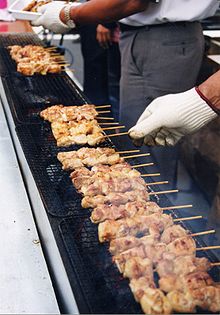Yakitori: Difference between revisions
No edit summary |
No edit summary |
||
| Line 13: | Line 13: | ||
Diners ordering yakitori usually have a choice of having it cooked with [[salt]] (shio) or with [[tare sauce]], which is generally made up of [[mirin]], [[sake]], [[soy sauce]] and [[sugar]]. The sauce is applied to the skewered meat and is grilled until delicately cooked. |
Diners ordering yakitori usually have a choice of having it cooked with [[salt]] (shio) or with [[tare sauce]], which is generally made up of [[mirin]], [[sake]], [[soy sauce]] and [[sugar]]. The sauce is applied to the skewered meat and is grilled until delicately cooked. |
||
* ''momo'' (もも), chicken thigh |
* ''momo'' (もも), chicken thigh |
||
* ''tsukune'' (つくね), chicken meatballs |
* ''[[tsukune]]'' (つくね), chicken meatballs |
||
* ''(tori)kawa'' ((とり)かわ) chicken skin, grilled until crispy |
* ''(tori)kawa'' ((とり)かわ) chicken skin, grilled until crispy |
||
* ''tebasaki'' (手羽先), chicken wing |
* ''tebasaki'' (手羽先), chicken wing |
||
| Line 39: | Line 39: | ||
|width=160 | height=170 | lines=4 |
|width=160 | height=170 | lines=4 |
||
|align=center |
|align=center |
||
|File:Yakitori assorted.jpg|''Kawa'' (chicken skin) |
|File:Yakitori assorted.jpg|'''Left to right:''' ''Kawa'' (chicken skin); ''[[Dioscorea_opposita|yamaimo]]''; ''[[shishito|shishitō]]'' |
||
|File:Yakitori - pork-wrapped asparagus, wings.jpg|Asparagus wrapped in thinly sliced pork |
|File:Yakitori - pork-wrapped asparagus, wings.jpg|'''Left to right:''' [[Asparagus]] wrapped in thinly sliced pork; chicken wings (splayed for even and faster cooking). |
||
|File:Yakitori - tsukune, scallion and pork belly.jpg|'''Left to right:''' ''Tsukune''; ''negi'' (scallion) and ''butabara'' (pork belly) |
|||
}} |
}} |
||
Revision as of 00:28, 14 April 2013
This article has multiple issues. Please help improve it or discuss these issues on the talk page. (Learn how and when to remove these messages)
No issues specified. Please specify issues, or remove this template. |


Yakitori (焼き鳥, やきとり, ヤキトリ), grilled chicken, is commonly a Japanese type of skewered chicken. The term "yakitori" can also refer to skewered food in general. Kushiyaki (skewer grilled), is a formal term that encompasses both poultry and non-poultry items, skewered and grilled. Both yakitori and kushiyaki mean the same, so the terms are used interchangeably in Japanese society.
Preparation
The average yakitori is made from several bite-sized pieces of chicken meat, or chicken offal, skewered on a bamboo skewer and grilled, usually over Binchōtan charcoal.
Diners ordering yakitori usually have a choice of having it cooked with salt (shio) or with tare sauce, which is generally made up of mirin, sake, soy sauce and sugar. The sauce is applied to the skewered meat and is grilled until delicately cooked.
- momo (もも), chicken thigh
- tsukune (つくね), chicken meatballs
- (tori)kawa ((とり)かわ) chicken skin, grilled until crispy
- tebasaki (手羽先), chicken wing
- bonjiri (ぼんじり), chicken tail
- shiro (シロ), chicken small intestines
- nankotsu (なんこつ), chicken cartilage
- hāto / hatsu (ハート / ハツ) or kokoro (こころ), chicken heart
- rebā (レバー), liver
- sunagimo (砂肝), or zuri (ずり) chicken gizzard
- toriniku, all white meat on skewer
Common non-poultry dishes
- ikada (筏) (lit. raft), Japanese scallion, with two skewers to prevent rotation
- gyūtan (牛タン), beef tongue, sliced thinly
- atsuage tōfu (厚揚げとうふ), thicker variety of deep-fried tofu
- enoki maki (エノキ巻き), enoki mushrooms wrapped in slices of pork
- pīman (ピーマン), green bellpepper
- asuparabēkon (アスパラベーコン), asparagus wrapped in bacon
- butabara (豚ばら), pork belly
- ninniku (にんにく)garlic
- shishito (獅子唐) Japanese pepper
-
Left to right: Asparagus wrapped in thinly sliced pork; chicken wings (splayed for even and faster cooking).
-
Left to right: Tsukune; negi (scallion) and butabara (pork belly)
See also
References
- Ono, Tadashi; Salat Harris (2011). The Japanese Grill: From Classic Yakitori to Steak, Seafood, and Vegetables. Ten Speed Press. ISBN 9781580087377
